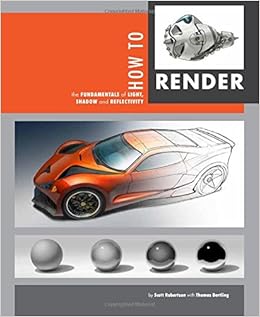
We have met with at the Lucca Comics and Games 2013 Show and we had the opportunity to get one of the first copies of “How to Draw”, the latest effort of the renown design instructor and concept designer. Differently from the other titles published by Scott’s Design Studio Press, which for the most part present inspirational artworks by concept designers and entertainment artists, “How To Draw” is a purely educational title that guides the reader from the basic skills to the more advanced drawing techniques, with the goal of enabling to sketch “objects and environments from your imagination”. In 208 pages Scott has packed a wealth of information, condensing his 18+ years of experience as a teacher at the Art Center College of Design in Pasadena (LA) and as a design instructor around the globe. In this effort the book was co-authored by Thomas Bertling, a designer, engineer and educator who is currently Director of Entertainment Design at the Art Center. The Content After a first chapter on drawing materials and basic exercises, “How To Draw” presents five chapters about drawing in perspective, an essential skill to visualize and present concepts and designs in a believable way. The topic is covered in great detail, with a particular focus on techniques for drawing and placing ellipses and for illustrating complex shapes with appropriate sections and curves – skills that are crucial for designers, concept artists and architects.
Motivacionnoe esse primer for kids. For your copy of How to Draw, please visit: design studio press Click around if you would like to review our privacy policy, or like to contact us, or just want to see what's up with Scott Robertson Workshops, or Design Studio Press.
In addition to the more usual topics there are also a number of less common subjects like using 3D underlays for drawings and curvilinear perspective. Then, the author presents three chapters specific for drawing environments, aircrafts and – obviously – wheeled vehicles, with an example of a fictional design brief featuring a futuristic hot rod. Those interested in automotive design will also find in this section very targeted tips and an interesting overview of the most common automotive styling lines.

This part, along with the final chapter presenting different sketching styles and mediums, provides a nice taste of what can be expected from the next books in the series, “How To Render” and “How To Design”. All the content is presented in such a way so that the reader is able to follow along the book step-by-step, with each chapter building on the concepts exposed in the previous ones. Digital content: the companion app “How To Draw” also features a free companion app – already available for Android and with an iOS version in the works – with over 10 hours of video content that further expand on the topics covered in the book. The app works in a very original and intuitive way: pointing the device camera at the book pages will trigger the related video contents, with a nice “augmented-reality” touch. There are also some interactive 3D models that allow to explore the designs in details and view them from every angle. Those who don’t have an iOS or Android device will be able to access all the additional content – apart from the 3D interactive models – on their computers or tablets through a standard web browser. Conclusions Given the completeness of the educational content, and the concise yet clear and pleasant writing style, “How To Draw” is a must-have textbook and reference for anyone who is interested in getting started or advancing his/her drawing skills and a very nice addition to any designer’s bookshelf.
The 10 hours of video training are far more than just a nice addition; they could be easily worth the price alone, making “How To Draw” a no-brainer purchase. Prasanna jothidam software download. “How to Draw” is available at the and on Amazon. The retail prices are $39.95 usd for the paperback edition and $54.95 usd for the hardcover version.